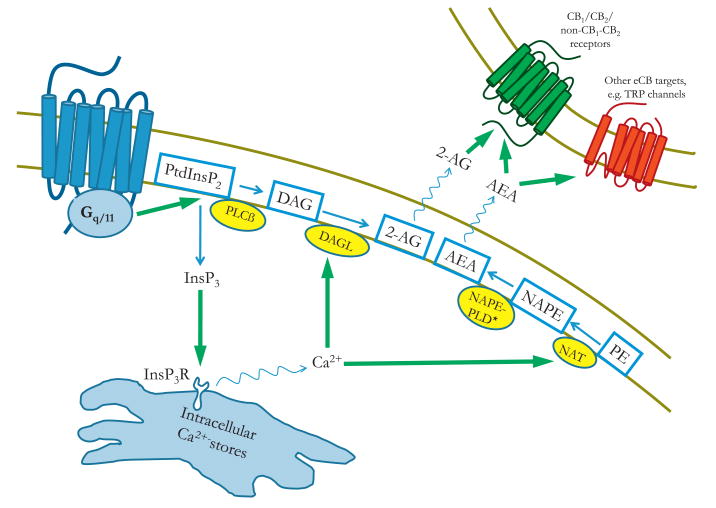Fig. 1.
Signaling mechanisms by which the activation of a Gq/11-coupled receptor enhances endocannabinoid production. Activation of a Gq/11-coupled receptor leads to the activation of phospholipase Cß enzyme, which cleaves PtdInsP2 in the plasma membrane to release InsP3 and DAG. DAG can serve as a substrate for the DAGL enzyme, which produces 2-AG in the cell membrane. On the other hand, InsP3 can trigger the release of Ca2+ from intracellular stores through InsP3R activation. The elevated cytoplasmic Ca2+ level can activate DAGL, further potentiating 2-AG production, as well as the NAT enzyme, leading to the production of NAPE, which can serve as a substrate for NAPE-PLD to yield AEA. * Indicates alternative pathways for anandamide production (see text for details). The released eCBs, after leaving the cell, can activate cannabinoid receptors or other eCB target molecules in a paracrine way. Abbreviations: PtdInsP2, phosphatidylinositol 4,5-bisphosphate; PLCß, phospholipase Cß; DAG, diacylglycerol; DAGL, diacylglycerol lipase; 2-AG, 2-arachidonoyl-glycerol; AEA, N-arachidonoyl-ethanolamine (anandamide); InsP3, inositol 1,4,5-trisphosphate; InsP3R, InsP3 receptor; NAPE, N-arachidonoyl-phosphatidylethanolamine; NAPE-PLD, NAPE-specific phospholipase D; NAT, N-acyltransferase; PE, phosphatidylethanolamine; TRP, transient receptor potential.

